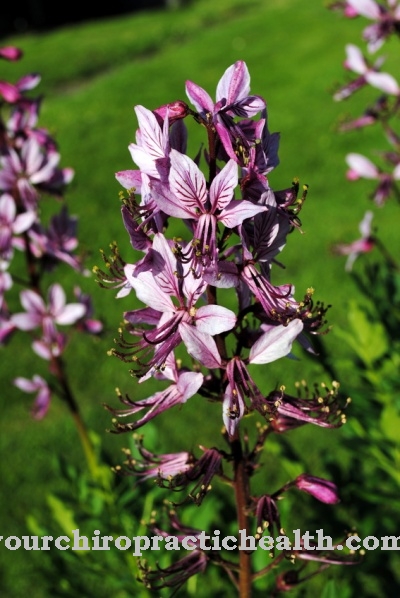The lupine is a beautiful plant to look at on roadsides and roadsides, but also in gardens at home. In addition to the major role it plays in agriculture, it is also of increasing importance for health.
Occurrence & cultivation of the lupine

Lupins, occasionally too Wolf beans or Fig beans called, belong to the legumes and, within this, to the subfamily of the butterflies. The name is derived from the Latin "lupus" (wolf), probably because of the hairy, wolf-gray pods of the seeds. The lupine is native primarily to North America and the Mediterranean area, depending on which species it is. The best known types of lupins are the blue, white and yellow lupins.
There is also the red cultivated form. Lupins prefer light and loamy soils with lots of sun. They are perennial and can reach heights of around 1.50 meters. The leaves are arranged like fingers. From June to August, depending on the color of the lupine, butterfly-shaped flowers appear on grapes that are 20 to 60 centimeters long. At the beginning of autumn, seeds form from the flowers in pods four to six centimeters long. The plant has deep roots that can reach one to two meters deep into the ground. Because it can form nitrogen in the root tubers, it is also often used for soil improvement and fertilization.
Effect & application
The seeds of wild lupins and garden lupins contain poisonous bitter substances, including lupinine and spartenine. The lupinine can cause fatal respiratory paralysis and the sparing can cause circulatory collapse. In history, however, lupins have always played an important role in the nutrition of humans and animals, and partly in medicine. The Egyptians already cultivated the plant and gave the seeds of the lupine to the pharaohs as grave goods.
In ancient Greece, doctors used the easy digestibility of seeds for treatment. In times of war and hardship, lupine seeds served as an important source of protein. The ability of the lupine as a soil fertilizer was valued in the past and is still today because it can bind nitrogen in the soil. In herbal medicine, lupins do not play such an important role because they have a fluctuating content of active ingredients, but they are even more important in nutrition.
However, the bitter alkaloids are dangerous to humans and animals. To make the seeds fit for nutrition, they used to be watered to filter out the toxins. In the 1920s, the cultivation of low-toxicity lupins was started to defuse this problem, since the protein, especially blue lupins, has a beneficial effect on lowering high cholesterol and blood lipid levels.
Scientific tests have yet to show how extensive this effect is. Today there are already alkaloid-free varieties, which means that the bitter substances are no longer extracted. In contrast to other legumes, lupins are not poisonous even when raw. Due to their low purine content, they are also suitable as nutrition for rheumatic diseases. Because they are gluten and lactose free, they are also tolerated by people with gluten and lactose intolerance.
In addition, they have a low glycemic index, do not raise blood sugar levels and are therefore also suitable for diabetics. Lupins are already used in many ways in nutrition: for dairy products, tofu, vegan burgers, sausages and other plant-based foods, and as flour in baked goods.
Because of their neutral taste, they can be used for all flavors from sweet to savory. From an ecological point of view, too, the lupine is a good alternative to soy, which has fallen into disrepute due to increasing genetic engineering and deforestation. Lupins grow even on barren, sandy soils.
Importance for health, treatment & prevention
Research has shown for a long time that the protein-containing seeds of lupins are a real alternative to soy. Particularly noteworthy is their high protein content with almost 40 percent protein, which can keep up with the soybean without any problems. It contains all essential amino acids, as well as vitamin A, vitamin B1 and important minerals such as calcium, iron, magnesium and potassium.
However, it has not yet been possible to provide evidence of vitamin B12. Similar to soy, lupins also contain phytoestrogens, but in much lower concentrations. Nevertheless, these are being researched because, according to scientific studies, phytoestrogens play an important role in the prevention of breast cancer, prostate cancer, cardiovascular diseases and osteoporosis.
The dietary fiber of the lupins is also beneficial to health with 15 percent of the seed. They ensure good digestion in the intestines and thus help prevent colon cancer. Studies also show a reduction in cholesterol levels. In addition to the dietary fiber, the high protein content of the plant contributes to the cholesterol-lowering effect, as research at the University of Halle has shown.
Lupine seeds contain less fat than soybeans (four to seven percent) and are rich in mono- and poly-saturated fatty acids. Due to the low glycemic index, they can also be used by diabetics. The allergy risk, however, is comparable to that of soy. Peanut allergy sufferers react to lupine components to a particularly high degree and also frequently. In France, there has been an increase in intolerance since lupine flour can be mixed with other cereal flours in unlimited amounts. Because of the risk of allergies, products containing lupins have been subject to labeling in the EU since 2007.





.jpg)







.jpg)

.jpg)
.jpg)











.jpg)